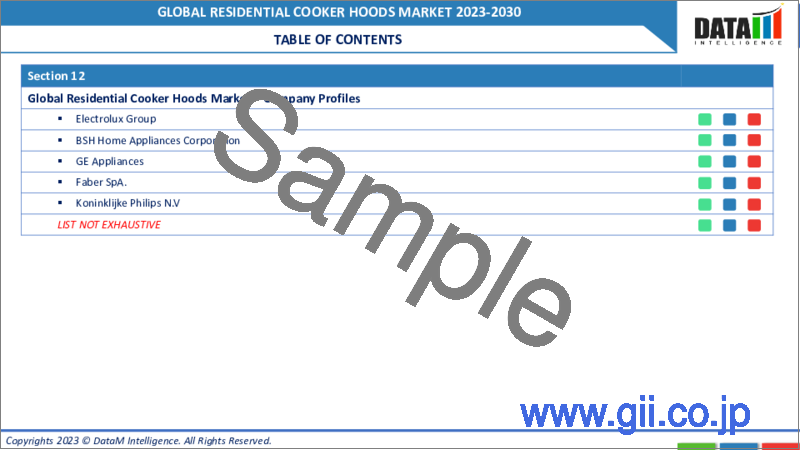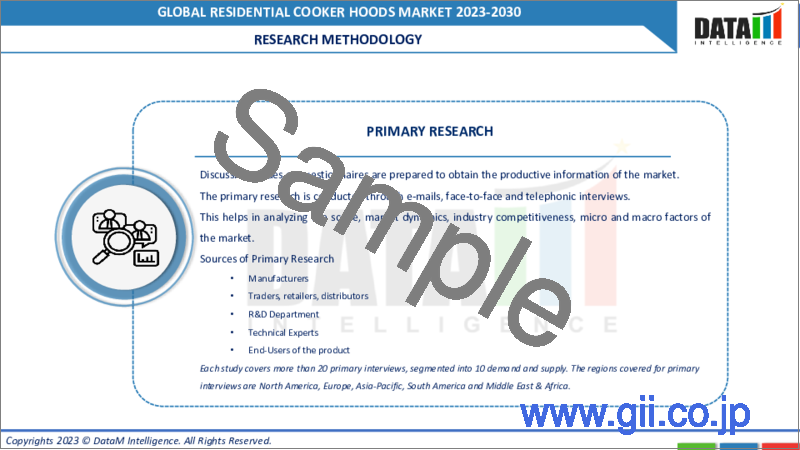|
|
市場調査レポート
商品コード
1074163
家庭用レンジフードの世界市場:2022年~2029年Global Residential Cooker Hoods Market - 2022-2029 |
||||||
|
● お客様のご希望に応じて、既存データの加工や未掲載情報(例:国別セグメント)の追加などの対応が可能です。 詳細はお問い合わせください。 |
|||||||
| 家庭用レンジフードの世界市場:2022年~2029年 |
|
出版日: 2022年05月07日
発行: DataM Intelligence
ページ情報: 英文 195 Pages
納期: 約2営業日
|
- 全表示
- 概要
- 目次
当レポートでは、世界の家庭用レンジフードの市場を調査し、市場の定義と概要、市場成長への各種影響因子の分析、法規制環境、市場規模の推移・予測、各種区分・地域/主要国別の内訳、競合環境、主要企業のプロファイルなどをまとめています。
目次
第1章 世界の家庭用レンジフード市場:調査手法・調査範囲
第2章 世界の家庭用レンジフード市場:市場の定義・概要
第3章 世界の家庭用レンジフード市場:エグゼクティブサマリー
第4章 世界の家庭用レンジフード市場:市場力学
- 市場影響要因
- 促進要因
- 抑制要因
- 市場機会
- 影響分析
第5章 世界の家庭用レンジフード市場:産業分析
- ポーターのファイブフォース分析
- サプライチェーン分析
- 価格分析
- 規制分析
第6章 世界の家庭用レンジフード市場:COVID-19の分析
- COVID-19:市場への影響分析
- COVID-19渦中の価格ダイナミクス
- 需給スペクトル
- パンデミック時の政府の市場関連イニシアチブ
- 製造業者の戦略的イニシアチブ
- 総論
第7章 世界の家庭用レンジフード市場:タイプ別
- 壁面設置フード
- アイランド型レンジフード
- ダウンドラフト型レンジフード
- 一体型レンジフード
- その他
第8章 世界の家庭用レンジフード市場:技術別
- ダクト
- ダクトレス
第9章 世界の家庭用レンジフード市場:材料別
- ステンレススチール
- 銅
- ブロンズ
- 亜鉛
- 強化ガラス
- アルミニウム
- 真鍮
- 耐熱プラスチック
第10章 世界の家庭用レンジフード市場:地域別
- 北米
- 欧州
- 南米
- アジア太平洋
- 中東・アフリカ
第11章 世界の家庭用レンジフード市場:競合情勢
- 競合シナリオ
- 市場の位置付け/シェア分析
- M&A分析
第12章 世界の家庭用レンジフード市場:企業プロファイル
- Samsung
- Whirlpool
- Instant Brands Inc
- Panasonic Corporation
- Elica s.p.A
- Electrolux Group
- BSH Home Appliances Corporation
- GE Appliances
- Faber SpA.
- Koninklijke Philips N.V
第13章 世界の家庭用レンジフード市場:重要考察
第14章 世界の家庭用レンジフード市場:DataM
- 付録
- 当社・サービスについて
- コンタクト
Market Overview
The residential cooker hoods market size was worth US$ XX million in 2021 and is estimated to reach US$ XX million by 2029, growing at a CAGR of XX % during the forecast period (2022-2029).
A range hood keeps cooking exhaust, smoke and chemicals from the kitchen. It improves the indoor air quality and streamlines your cooking experience. Studies show that air can be unhealthy to breathe when people cook in kitchens with poor ventilation. The best way to ventilate the kitchen is to use a properly-installed, high-efficiency range hood over the stove. A high-efficiency range hood has high cubic feet per minute and low sones ratings.
The range hood is categorized into 2 major technologies: ducted and ductless hoods. Ducted hoods are range hoods that vent to the outside of the home. The hoods are efficient and powerful at removing strong odors from the kitchen. A properly installed ducted hood can efficiently rid the home of the lingering smells associated with food or other highly aromatic cooking styles. In contrast, ductless hoods recirculate the air back into your home and are not ideal for strong-smelling and high-heat cooking.
Market Dynamics
The global residential cooker hoods market is boosted by the need for effective systems to curb indoor air pollution.
Need for effective systems to curb indoor air pollution
Cooking is done with various heat sources, including gas and electricity. During cooking, any of the sources can contribute to indoor air pollution. Carbon monoxide, formaldehyde and other hazardous chemicals released by natural gas and propane burners can be toxic to people and pets.
Some states, such as California, have strict ventilation rules that homeowners must follow. Ventilation requirements for single-family dwellings must comply with Chapter 4 of the California Mechanical Code or ASHRAE 62.2, according to Section 402.1.2 of the California Mechanical Code. To achieve home ventilation regulations, "ASHRAE" stipulates that kitchen spaces must have mechanical ventilation. The installation of a range hood is one of the most effective ways to create this mechanical ventilation in a kitchen.
Various major smart kitchen appliances have been recently launched in the market, which highlights easy cooking practices. For instance, in 2021, FOTILE announced the launch of the brand's latest range hood, Pixie Air. The Pixie Air Range Hood enhances extraction power and whisks smoke, steam and grease with two Capture Shields. The Pixie Air range hood also incorporates important safety features, including the Intelligent Air Management System that automatically detects harmful organic gasses or toxic fumes and vents them out of the home.
High prices of hoods
Due to the high initial costs of range hoods, lower-middle-class families opt for the alternatives, which act as a restraining factor for the market. Many users favor economic ventilation systems such as exhaust fans as an alternative to the range hoods in emerging economies. Having a kitchen range hood that exceeds the demands is noisy and incurs unnecessary costs that should not be incurred in the first place. A range hood has a larger and more powerful blower that uses a lot of electricity. As a result, the monthly energy expenditures will soar, resulting in wasteful spending on unnecessary items.
Moreover, their range hoods also need maintenance costs, including frequent filter replacement and ventilation area cleaning. The price of range hoods depends on several factors, such as the CFM rating, its special features and their blowing mode. In contrast, cheap residential range hoods lack the power for conventional ventilation in the kitchen, which needs to be changed sooner or later.
COVID-19 Impact Analysis
The market for major domestic cooking appliances has grown exponentially during the COVID-19 outbreak. During the pandemic, people spent a lot of time inside the home, which resulted in home cooking habits. Consumers were looking for top-class products for storage, cooking and even cleaning chores. Consumers are spending more time in the kitchens due to the worldwide lockdown. According to a survey, people in the U.S continue to cook more, with 71% stating they will do so after the pandemic. The increase in home cooks creativity and confidence in the kitchen and the motivation that cooking at home saves money, allows them to eat better and makes them feel good are all driving this behavior.
The Association of Home Appliance Manufacturers surveyed over U.S residents in 2020 to determine the appliances they purchased during the pandemic. Two out of five people voted that they had bought at least two more appliances since the start of the pandemic. Small kitchen appliances were the second most common category, with 32% of respondents reporting purchases. The appliances were likely being put to good use, as nearly half of respondents said cooking at home after the pandemic.
Segment Analysis
The residential cooker hoods market is segmented into ducted and ductless by technology.
Consumer looking for quieter and more efficient range hoods in the kitchen is boosting the sales of ducted hoods
Ducted hoods are typically found in commercial kitchens or homes with larger ranges, which produce more smoke, fumes or unclean air that needs to be vented outdoors. Ducted hoods are more effective at removing humidity and steam from the cooking area because they do not filter and recirculate the air instead of venting it totally out of the kitchen. Ducted hoods are considered to run more efficiently and tend to be quieter. However, it must be installed in an area where a duct system goes from inside the kitchen to the home's exterior.
Various companies have launched new products, which are expected to strengthen the ducted residential cooker hoods market demand. For instance, in 2021, Franke has expanded its range of cooker hoods by launching two new RRP-priced variants. Joy has T-shaped stainless steel construction and comes in two widths of 60cm and 90cm. It has three speeds and a maximum extraction rate of 430 m3/h. Gavia also has a traditional T-shape and is available in stainless steel or black.
Geographical Analysis
Developing cooking at home habits in the countries is boosting sales in the Asia-Pacific
The increasing popularity of the cook-at-home trend in the region is boosting the market growth. Consumers prioritize cooking more at home in emerging countries to save money, eat healthy food, spend time with family and convenience. The consumer emphasizes a powerful and efficient range hood to keep the kitchen clean and free of strong odors. Moreover, the pandemic has also been a major factor in boosting the market growth in the region. Thai people are shifting to cook more and are more health-conscious in their dietary choices since the pandemic forced them to remain more time at home. The majority of the consumers, almost 70.94%, said they had given more attention to food now than before the COVID-19 outbreak.
The emerging trends for cooking at home will boost the demand for residential cooker hoods in the region. For instance, in 2019, According to a study released by Kitchen Stories, it emerged that 31.11% of Chinese citizens cooked for their families every day. In 2020, according to a Japanese survey, the majority of the respondents cooked meals at least once per week. While the largest share, almost 46%, stated preparing food almost every day at home.
Competitive Landscape
The residential cooker hoods market is fragmented with the presence of global companies. The market has availability of products depending on the featured needed and budget of customers. In addition, players contributing to the residential cooker hoods market growth are Samsung, Whirlpool, Instant Brands Inc, Panasonic Corporation, Elica s.p.A, Electrolux Group, BSH Home Appliances Corporation, GE Appliances, Faber SpA., Koninklijke Philips N.V and others. The players are adopting strategies to dominate the market, such as launching new products, acquisitions and expansions, contributing to the global growth of the residential cooker hoods market.
SWM International
Overview: Samsung is a multinational manufacturing conglomerate headquartered in Samsung Town, Seoul, South Korea. The company has over 267,000 employees across 75 countries globally. The company has 15 regional offices, 36 production sites, 39 R&D centers and 53 sales offices.
Product Portfolio: The company manufactures numerous types of wall mounts and under cabinet range hoods for residential purposes.
Key Development: In 2018, Samsung Electronics announced to speed up market penetration of its premium built-in home appliances in America with Dacor in the U.S. The two companies showcased their premium built-in appliances at the Pacific Coast Builders Conference, including Chef Collection 36" Gas Pro Range and the Chef Collection 36" Canopy Pro Range Hood.
Why Purchase the Report?
Visualize the residential cooker hoods market segmentation by type, technology, material and region, highlighting the key commercial assets and players.
Identify commercial opportunities in residential cooker hoods by analyzing trends and co-development deals.
Excel data sheet with thousands of data points of residential cooker hoods market-level 4/5 segmentation.
PDF report with the most relevant analysis cogently put together after exhaustive qualitative interviews and in-depth market study.
Product mapping in excel for the key product of all major market players
The global residential cooker hoods market report would provide an approximate 61 market data table, 58 figures and 195 pages
Target Audience
Buyers
Industry Investors/Investment Bankers
Raw Material Providers
Range hood Manufacturers
Education & Research Institutes
Research Professionals
Emerging Companies
Distributors
Table of Contents
1. Global Residential Cooker Hoods Market Methodology and Scope
- 1.1. Research Methodology
- 1.2. Research Objective and Scope of the Report
2. Global Residential Cooker Hoods Market - Market Definition and Overview
3. Global Residential Cooker Hoods Market - Executive Summary
- 3.1. Market Snippet by Type
- 3.2. Market Snippet by Technology
- 3.3. Market Snippet by Material
- 3.4. Market Snippet by Region
4. Global Residential Cooker Hoods Market-Market Dynamics
- 4.1. Market Impacting Factors
- 4.1.1. Drivers
- 4.1.1.1. Need for effective systems to curb indoor air pollution
- 4.1.1.2. XX
- 4.1.2. Restraints:
- 4.1.2.1. High prices of hoods
- 4.1.2.2. XX
- 4.1.3. Opportunity
- 4.1.4. Impact Analysis
- 4.1.1. Drivers
5. Global Residential Cooker Hoods Market - Industry Analysis
- 5.1. Porter's Five Forces Analysis
- 5.2. Supply Chain Analysis
- 5.3. Pricing Analysis
- 5.4. Regulatory Analysis
6. Global Residential Cooker Hoods Market - COVID-19 Analysis
- 6.1. Analysis of COVID-19 on the Market
- 6.1.1. Before COVID-19 Market Scenario
- 6.1.2. Present COVID-19 Market Scenario
- 6.1.3. After COVID-19 or Future Scenario
- 6.2. Pricing Dynamics Amid COVID-19
- 6.3. Demand-Supply Spectrum
- 6.4. Government Initiatives Related to the Market During Pandemic
- 6.5. Manufacturers Strategic Initiatives
- 6.6. Conclusion
7. Global Residential Cooker Hoods Market - By Type
- 7.1. Introduction
- 7.1.1. Market Size Analysis and Y-o-Y Growth Analysis (%), By Type
- 7.1.2. Market Attractiveness Index, By Type
- 7.2. Wall Mounted Hoods*
- 7.2.1. Introduction
- 7.2.2. Market Size Analysis And Y-O-Y Growth Analysis (%)
- 7.3. Island Cooker Hoods
- 7.4. Downdraft Cooker Hoods
- 7.5. Integrated Cooker Hoods
- 7.6. Others
8. Global Residential Cooker Hoods Market - By Technology
- 8.1. Introduction
- 8.1.1. Market Size Analysis and Y-o-Y Growth Analysis (%), By Technology
- 8.1.2. Market Attractiveness Index, By Technology
- 8.2. Ducted*
- 8.2.1. Introduction
- 8.2.2. Market Size Analysis And Y-O-Y Growth Analysis (%)
- 8.3. Ductless
9. Global Residential Cooker Hoods Market - By Material
- 9.1. Introduction
- 9.1.1. Market Size Analysis and Y-o-Y Growth Analysis (%), By Material
- 9.1.2. Market Attractiveness Index, By Material
- 9.2. Stainless steel*
- 9.2.1. Introduction
- 9.2.2. Market Size Analysis And Y-O-Y Growth Analysis (%)
- 9.3. Copper
- 9.4. Bronze
- 9.5. Zinc
- 9.6. Tempered glass
- 9.7. Aluminum
- 9.8. Brass
- 9.9. Heat-resistant plastic
10. Global Residential Cooker Hoods Market - By Region
- 10.1. Introduction
- 10.2. Market Size Analysis and Y-o-Y Growth Analysis (%), By Region
- 10.3. Market Attractiveness Index, By Region
- 10.4. North America*
- 10.4.1. Introduction
- 10.4.2. Key Region-Specific Dynamics
- 10.4.3. Market Size Analysis and Y-o-Y Growth Analysis (%), By Type
- 10.4.4. Market Size Analysis and Y-o-Y Growth Analysis (%), By Technology
- 10.4.5. Market Size Analysis and Y-o-Y Growth Analysis (%), By Material
- 10.4.6. Market Size Analysis and Y-o-Y Growth Analysis (%), By Country
- 10.4.6.1. U.S.
- 10.4.6.2. Canada
- 10.4.6.3. Mexico
- 10.5. Europe
- 10.5.1. Introduction
- 10.5.2. Key Region-Specific Dynamics
- 10.5.3. Market Size Analysis and Y-o-Y Growth Analysis (%), By Type
- 10.5.4. Market Size Analysis and Y-o-Y Growth Analysis (%), By Technology
- 10.5.5. Market Size Analysis and Y-o-Y Growth Analysis (%), By Material
- 10.5.6. Market Size Analysis and Y-o-Y Growth Analysis (%), By Country
- 10.5.6.1. Germany
- 10.5.6.2. U.K.
- 10.5.6.3. France
- 10.5.6.4. Italy
- 10.5.6.5. Spain
- 10.5.6.6. Rest of Europe
- 10.6. South America
- 10.6.1. Introduction
- 10.6.2. Key Region-Specific Dynamics
- 10.6.3. Market Size Analysis and Y-o-Y Growth Analysis (%), By Type
- 10.6.4. Market Size Analysis and Y-o-Y Growth Analysis (%), By Technology
- 10.6.5. Market Size Analysis and Y-o-Y Growth Analysis (%), By Material
- 10.6.6. Market Size Analysis and Y-o-Y Growth Analysis (%), By Country
- 10.6.6.1. Brazil
- 10.6.6.2. Argentina
- 10.6.6.3. Rest of South America
- 10.7. Asia Pacific
- 10.7.1. Introduction
- 10.7.2. Key Region-Specific Dynamics
- 10.7.3. Market Size Analysis and Y-o-Y Growth Analysis (%), By Type
- 10.7.4. Market Size Analysis and Y-o-Y Growth Analysis (%), By Technology
- 10.7.5. Market Size Analysis and Y-o-Y Growth Analysis (%), By Material
- 10.7.6. Market Size Analysis and Y-o-Y Growth Analysis (%), By Country
- 10.7.6.1. China
- 10.7.6.2. India
- 10.7.6.3. Japan
- 10.7.6.4. Australia
- 10.7.6.5. Rest of Asia Pacific
- 10.8. Middle East and Africa
- 10.8.1. Introduction
- 10.8.2. Key Region-Specific Dynamics
- 10.8.3. Market Size Analysis and Y-o-Y Growth Analysis (%), By Type
- 10.8.4. Market Size Analysis and Y-o-Y Growth Analysis (%), By Technology
- 10.8.5. Market Size Analysis and Y-o-Y Growth Analysis (%), By Material
11. Global Residential Cooker Hoods Market - Competitive Landscape
- 11.1. Competitive Scenario
- 11.2. Market Positioning/Share Analysis
- 11.3. Mergers and Acquisitions Analysis
12. Global Residential Cooker Hoods Market- Company Profiles
- 12.1. Samsung*
- 12.1.1. Company Overview
- 12.1.2. Product Portfolio and Description
- 12.1.3. Key Highlights
- 12.1.4. Financial Overview
- 12.2. Whirlpool
- 12.3. Instant Brands Inc
- 12.4. Panasonic Corporation
- 12.5. Elica s.p.A
- 12.6. Electrolux Group
- 12.7. BSH Home Appliances Corporation
- 12.8. GE Appliances
- 12.9. Faber SpA.
- 12.10. Koninklijke Philips N.V
LIST NOT EXHAUSTIVE
13. Global Residential Cooker Hoods Market - Premium Insights
14. Global Residential Cooker Hoods Market - DataM
- 14.1. Appendix
- 14.2. About Us and Services
- 14.3. Contact Us




